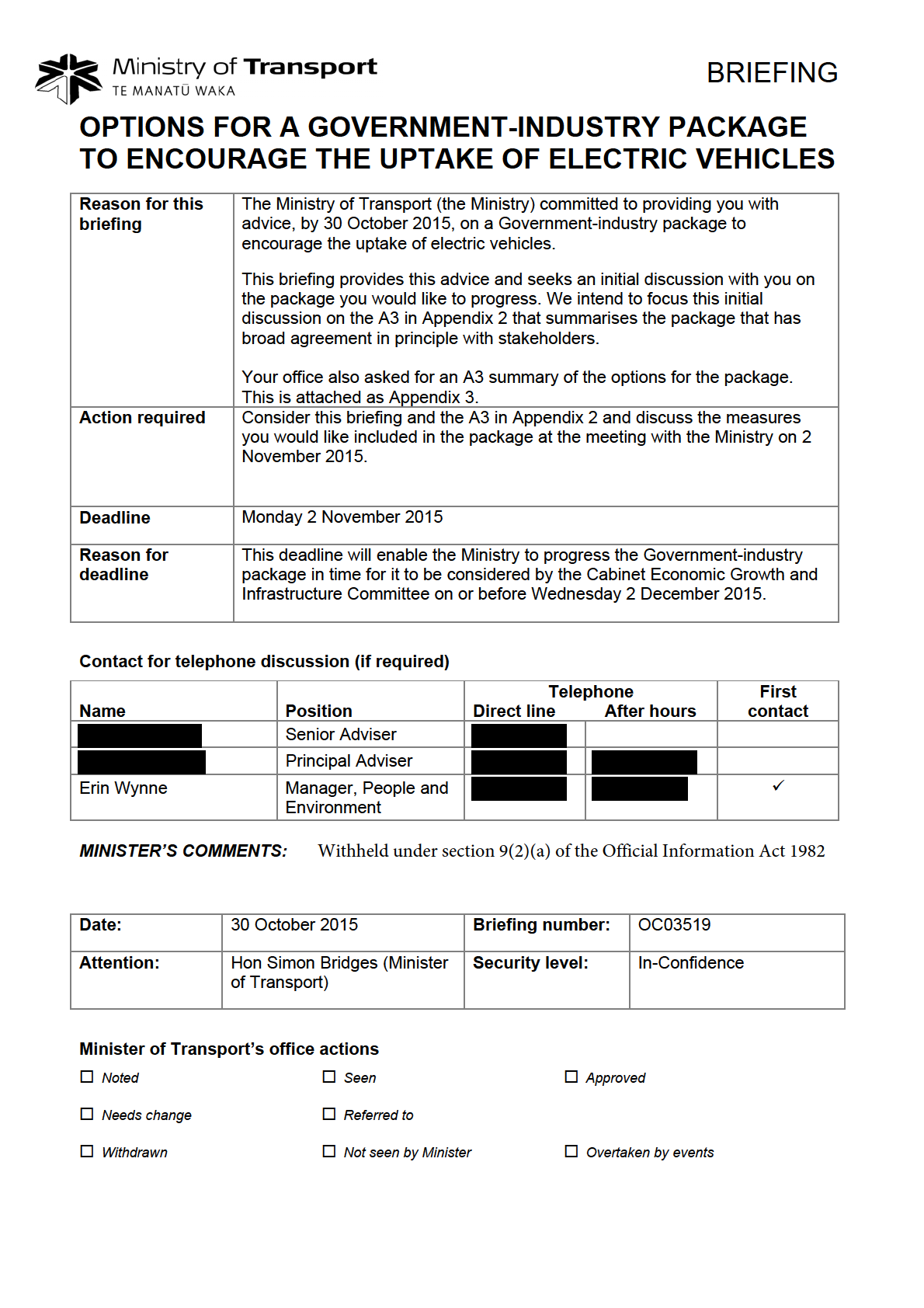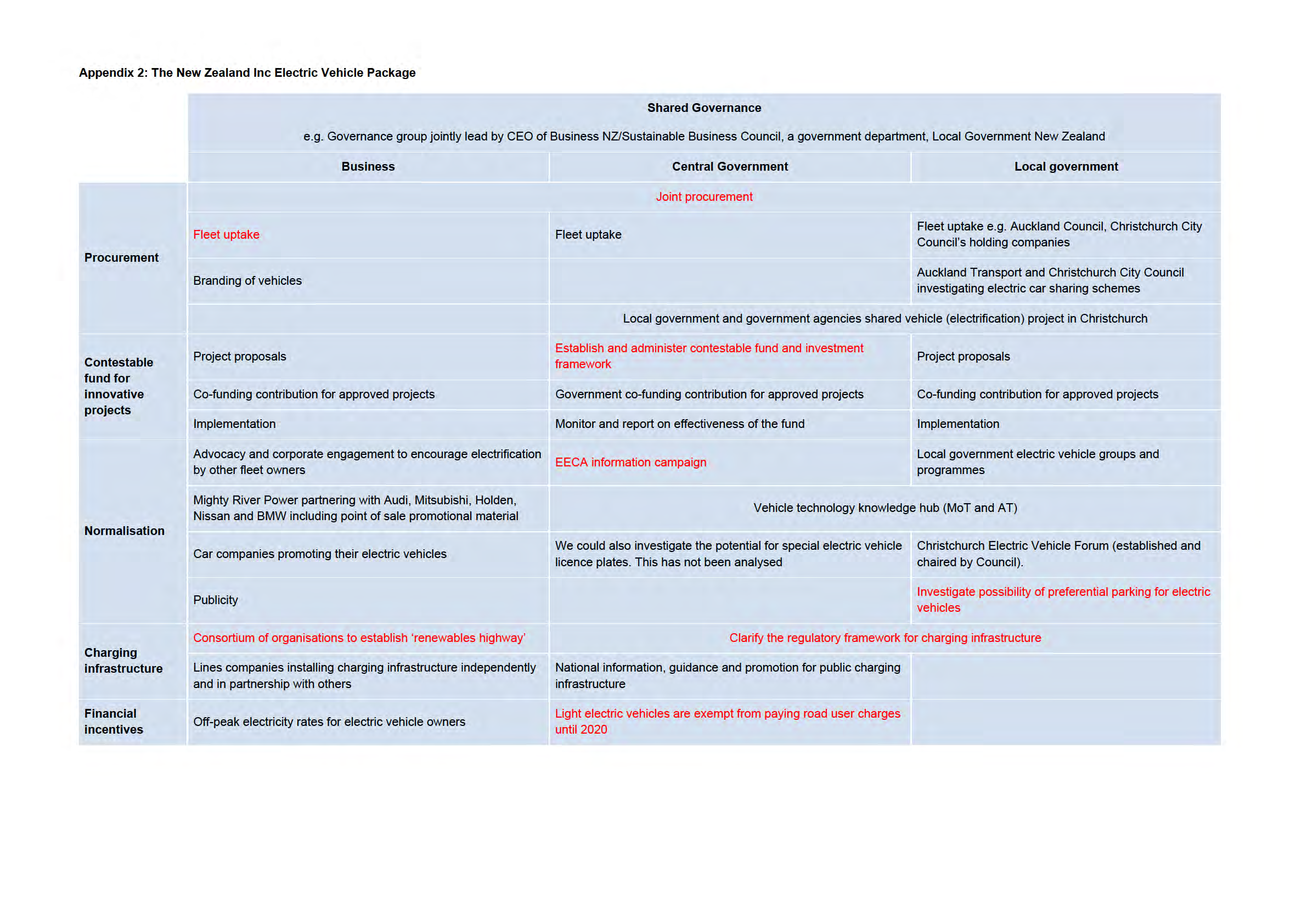

 Purpose of report
Purpose of report
1.
This briefing seeks direction from you on the measures you would like progressed as a
Government-industry package to encourage the uptake of electric vehicles (EVs). It also
seeks an initial discussion with you at our meeting on 2 November 2015. We would like to
focus this initial discussion on the A3 in Appendix 2 that summarises the package that has
been developed with stakeholders.
2.
The A3 in Appendix 3 is intended for your meeting with the Prime Minister and senior
Ministers on 11 November 2015. It outlines the options for the package coupled with their
costs as requested by your office.
Your previous decisions on measures to encourage the uptake of EVs
3.
New Zealand will be looking to reduce its transport emissions to help give effect to its post-
2020 greenhouse gas emissions reduction target. If conventional vehicles could increasingly
be substituted with EVs, New Zealand would reduce its transport emissions without
compromising individual mobility or economic growth.
4.
In considering the advice we provided on 26 March 2015 (OC02885 attached), you agreed in
April that initiatives to encourage the uptake of EVs should include:
4.1.
an information and promotion campaign by the Energy Efficiency and Conservation
Authority (EECA)
4.2.
government branding, promotion and information support for public charging
infrastructure
4.3.
a trial of EVs in government fleets.
5.
At a subsequent meeting on 27 July 2015, you asked officials to work with local government
and industry to ‘co-create’ a package of measures to encourage the uptake of EVs. You also
indicated that discussions with these stakeholders could traverse a range of options to
reduce the risks and costs for suppliers and purchasers of EVs.
6.
As in our previous advice, we define EVs as being motor vehicles powered by electric
batteries and plug-in hybrid electric vehicles. Not included in this definition are conventional
hybrid vehicles, which have an internal battery but need petrol or diesel to run.
The process we followed to co-create a Government-industry EVs package
7.
To effect a co-creation policy process Martin Matthews brought together a group of chief
executives from industry, local government and central government agencies. A list of the
chief executives involved is in Appendix 1.
8.
This group met on 10 September 2015 and was tasked with developing:
8.1.
joint targets specifying a reasonable level of EV uptake that New Zealand can aspire
to
8.2.
a Government-industry EVs package that parties would commit to, even conditionally,
to achieve the joint targets
8.3.
a governance arrangement that would bring the relevant public and private sector
parties together on an ongoing basis to drive uptake.
Page 2 of 16

9.
On 12 October, members of the Sustainable Business Council, and local and central
government officials came together to workshop a package. On 28 October, chief executives
met to consider the draft package of measures to recommend to you. This briefing and the
A3 in Appendix 2 reflect this draft package of measures.
The draft package of measures focuses on reducing the barriers that are limiting the uptake
of EVs
10.
The draft package of measures aims to reduce the barriers that are limiting the appeal of
EVs to consumers and businesses. These barriers are the:
10.1. relatively higher purchase prices. Although purchase prices have fallen, prices of EVs
are still higher than their equivalent conventional vehicles. Most consumers do not
recognise the additional value of EVs, such as their environmental benefits
10.2. limited travel range of EVs. The range of pure EVs is generally up to 150 kilometres
before they require recharging. This makes their use for long journeys less appealing
10.3. very limited range of EV models available in New Zealand. The small EV range has
to compete in the market against the substantially wider range of conventional
vehicles. Many conventional vehicles offer superior features and good fuel efficiency
10.4. information problems. These problems include a lack of awareness of EVs,
uncertainty about the total costs of ownership (for instance maintenance costs,
battery life and residual values) and misconceptions about EVs
10.5. coordination problems. For example, consumers and businesses may be reluctant to
purchase EVs without public charging infrastructure being widely available. However,
the private sector may be reluctant to invest in a comprehensive charging network
until there is widespread uptake of EVs.
11.
The barriers of purchase price and travel range will reduce in the medium term. Industry
experts expect electric vehicles to reach price parity with conventional vehicles between
2018 and 2025. Battery technology is also likely to improve, extending the travel range of
EVs. These improvements will make the economic case for adopting EVs more compelling
for consumers and businesses.
12.
However, in the absence of government intervention, the barriers relating to the limited range
of EV models, information and coordination are unlikely to reduce quickly enough for EVs to
be a credible part of New Zealand’s strategy to reduce transport emissions.
13.
This is because the information and coordination barriers are to an extent market failures.
The level of cost and risk that the motor vehicle industry and electricity providers would face
in addressing them is likely to be prohibitive. The availability of a wider range of models is
likely to follow the increased uptake of EVs in the New Zealand market, but could be
improved through government intervention in the short term.
The draft package of measures
14.
The A3 in Appendix 2 outlines the draft package. It covers the initiatives that are being, or
could be, done to increase the uptake of EVs. The package has five elements:
14.1. procurement across private and public sector fleets
14.2. a contestable fund for innovative projects
Page 3 of 16

14.3. normalisation to make EVs a regular vehicle choice
14.4. charging infrastructure
14.5. financial incentives.
15.
Of these elements, stakeholders broadly agree that the Government-industry package
should focus primarily on the first three elements, as the other two are already in place, or
underway. Nevertheless, this paper includes measures that would enhance both of the last
two elements.
16.
These measures are the three measures that you agreed in April, see paragraph 4 above,
and six new measures that are discussed in paragraphs 19–62.
17.
To be included in the proposed package initiatives had to pass the test that they:
17.1. will work with the other measures to collectively address the barriers that are limiting
the appeal of EVs to consumers and businesses
17.2. offer benefits in barrier reduction that are likely to outweigh their costs and risks.
18.
The total cost of the package will depend on the level of ambition under the package. For the
EVs package to have momentum, we estimate that if all options were included at least $5–
10 million per annum for 5 years would be required. Additional Crown funding would be
sought for the package as part of Budget 2016.
Procurement measures to facilitate an increase in the number of EVs in fleet purchases
Joint procurement for government and private sector fleets
19.
The key procurement initiative from the co-creation process is to have joint EV procurement
for government and private sector fleets. This initiative would aggregate vehicle purchases in
order to achieve lower prices and/or an increase in the number of EV models available.
20.
The initiative envisages a government agency co-ordinating the joint procurement with a
commitment from public agencies and private businesses to purchase a set number of EVs.
The Ministry of Business, Innovation and Employment (MBIE) could act as the co-ordinating
agency but it would require a clear mandate from Cabinet and, potentially, additional funding.
21.
The need for joint procurement would diminish with time. It would not be needed once the
purchase price of EVs nears that of conventional vehicles.
22.
Joint procurement would be successful if it achieves a price discount, or an increase in
model availability, that outweighs the costs and risks involved. The risks are that:
22.1. even with joint procurement the volume of vehicles purchased may be too low to
influence purchase prices or model availability
22.2. the procurement agent negotiates the procurement of a number of vehicles that are
then not wanted by their would-be buyers. It could then be left with the costs involved,
including arranging for the sale of the surplus vehicles
22.3. it could reduce the ability of the existing mechanisms of vehicle procurement to
secure ongoing savings and reasonable delivery options. For instance, the All-of-
Government contract for vehicle procurement could be negatively impacted.
Page 4 of 16

23.
We would need to analyse the significance of these issues before this option is progressed.
The arrangements for joint procurement would also need to be developed.
24.
We have had initial discussions with MBIE about this initiative. It has advised that it could
undertake an assessment of the feasibility of the initiative by March 2016 if funding were
provided. It would need funding because MBIE’s procurement unit operates on a cost-
recovery basis.
25.
Given the need for further work, if you support this option we advise seeking Cabinet
agreement in principle for it at this stage.
A trial of EVs in government fleets
26.
You previously agreed that an EV trial in government fleets should be considered as part of
the Government-industry package. In light of the joint procurement initiative we would like to
discuss with you whether you still want to pursue an EV trial.
27.
The type of trial we had previously discussed envisaged trialling 24 vehicles in four
government fleet locations. This would require one-off funding of approximately $500,000 to
cover the incremental costs of the trial vehicles. Industry feedback was that a trial at this
level lacked credibility given the level of fleet uptake by leading businesses (for instance Air
New Zealand, which is converting its whole fleet to EVs where feasible).
28.
Discussions with MBIE suggest that a trial could be scaled up, for example, by adding an
additional 24 vehicles each year. To put this in perspective, currently there are over 20,000
vehicles in the government fleet. Around 4,000 new vehicles are purchased through the All-
of-Government contract each year. About 42 percent of these purchases are for compact
passenger vehicles, like the Toyota Corolla.
A financial ‘kickstarter’ for the purchase of EVs in government fleets
29.
Alongside the joint procurement initiative the Government could consider providing a
financial ‘kickstarter’ to incentivise the purchase of EVs in government fleets. The kickstarter
was not discussed during the co-creation process, so is not included in the summary of the
whole package (Appendix 2) or the summary of options and costings (Appendix 3).
30.
We know from discussions with MBIE that government agencies are facing difficulties in
maintaining their current fleets and have been delaying the replacement of vehicles. The
kickstarter is one way of overcoming barriers to government fleet buyers adopting EVs.
31.
The kickstarter would involve one-off Crown funding to cover the price differential between a
conventional vehicle and an EV equivalent. Funding of $1 million would fund around 100
EVs.
32.
The key risk with a financial kickstarter is that it could attract criticism regarding the use of
public money in a constrained fiscal environment.
33.
This risk could be mitigated by making it clear that the initiative will yield a positive public
outcome. This outcome is demonstrating to businesses and individuals how New Zealand
can transition to a lower carbon future.
Page 5 of 16
 A contestable fund for innovative projects that reduce the barriers to EV uptake
A contestable fund for innovative projects that reduce the barriers to EV uptake
34.
To maximise the efforts of industry and government in addressing the barriers to EV uptake
and to encourage innovation a contestable fund could be included in the package. The fund
would be akin to the Urban Cycleways Programme in that it would co-fund projects
developed by businesses or local communities.
35.
In our view, a co-fund is warranted because the barriers require a joint Government-industry
effort to reduce them. Key to the government role is reducing the risks and costs that the
motor vehicle industry and electricity providers face in growing demand for EVs.
36.
Examples of the type of projects that could be co-funded include:
36.1. the creation and promotion of branded tourism routes using EVs. On such routes
tourists could hire EVs, and preferentially park and charge them at participating
tourist attractions, information centres, cafes and accommodation venues
36.2. demonstrations of vehicle types currently not used in New Zealand, such as electric
vans in commercial fleets.
37.
The contestable fund would require Crown funding with the actual amount depending on the
level of ambition sought and the expected impact of EV uptake of any initiatives. In our view,
an appropriate amount would be in the order of $5–10 million per annum over five years. We
consider that this amount could co-fund up to 10 to 20 projects.
38.
The key risk with providing government funding is that it could fund initiatives that local
government or industry may have provided anyway. This risk would be reduced through the
co-funding approach. Further, the fund’s criteria would be designed to ensure that only
initiatives warranting government investment are funded.
39.
If you support this option the Cabinet paper for the package would seek an in-principle
agreement to establish a contestable fund. You would then seek agreement on the quantum
of funding, the criteria for assessing proposals and on the administrative arrangements at a
later date.
Normalisation to make EVs a regular vehicle choice
Having targets for uptake to demonstrate commitment and focus effort
40.
Targets for EV uptake also warrant consideration. Targets would demonstrate the
Government’s commitment to reducing transport emissions via EVs. They would also
provide a tangible way to focus government and industry efforts in this area.
41.
Targets would contribute to tackling the information barrier by raising awareness of EVs
among consumers and businesses. This would help to normalise perceptions about the
purchase of an EV. For instance, by changing the perception of an EV being a risky vehicle
to purchase to it being a regular vehicle choice.
42.
For the year ended 30 September 2015, 438 EVs were sold bringing the total number of EVs
in our light vehicle fleet to 817. This is 0.024 percent of the light vehicle fleet.
43.
In our modelling, the status quo scenario forecasts EVs being around 12 percent of new
vehicles sold in 2020. This is about 11,500 vehicles. This means that there will be about
43,000 EVs by 2020 (including used EVs) which is over 1 percent of the light vehicle fleet.
Page 6 of 16

44.
The proposed package would set the following targets for EV uptake:
44.1. 1,000 EV sales in 2016
44.2. 5,000 EV sales in 2017
44.3. 25,000 EV sales in 2019.
45.
The proposed targets are very ambitious, particularly the one for 2019. We will be stress
testing these targets with industry representatives on 2 November 2015 using available
modelling. This is important as all parties involved in developing the draft package want
targets that are ambitious but still credible.
46.
As part of this stress test, parties will need to consider how far the joint package will take us
towards the targets and the respective contributions that would be required from central
government agencies, local government and business.
47.
The key risk with specifying targets is that ultimately they may not be met. Non-achievement
could give opponents an opportunity to criticise Government policy. In our view, however,
this risk is limited by the fact that the package will be a joint Government-industry one.
48.
The risk could also be mitigated by stating at the outset that the targets are deliberately
ambitious and have been set primarily to galvanise effort.
Other normalisation initiatives in the package
49.
In addition to targets, the following measures that you agreed to in April will assist with
making EVs a regular vehicle choice:
49.1. an information and promotion campaign by the Energy Efficiency and Conservation
Authority (EECA)
49.2. government branding, promotion and information support for public charging
infrastructure.
Replacing the remainder of the road user charges exemption with upfront payments to EV
purchasers
50.
As an alternative to allowing the current road user charges (RUC) exemption to run to 2020,
we could investigate the option of converting it into upfront payments to encourage the
purchase of EVs.
51.
With this option the RUC exemption would end on 30 June 2016. In its place, purchases of
EVs would come with a one-off upfront payment equivalent to the average amount of RUC
that would have been paid up to 2020.
52.
For example, someone purchasing an EV on 1 July 2016 would receive a one-off upfront
payment of around $2,5001. Each year they would be required to pay RUC like all other
vehicle owners. Assuming 10,000 kilometres are driven in a year, the annual RUC amount
would be $620 (GST inclusive). Someone purchasing an EV on 1 July 2019 would receive
an upfront payment of $620 and pay RUC of a similar amount.
1 This is based on the existing RUC rate of $62 per 1,000 kilometres (GST inclusive) and an average distance
travelled of 10,000 kilometres. The actual upfront payment would be $2,480.
Page 7 of 16

53.
To ensure current owners of EVs are not disadvantaged EVs registered before the
exemption expires on 1 July 2016 would continue to be exempt from RUC until 2020.
54.
This measure would offer a stronger financial incentive for people to purchase EVs than the
current RUC exemption. Generally, there is more benefit in receiving a one-off upfront
payment than in being exempt from paying out the same amount of money over several
years. This reflects the falling value of money in an environment with inflation.
55.
The option would also be fiscally neutral for the National Land Transport Fund (NLTF). This
is because the monies needed for the upfront payments would be recovered from RUC.
However, the NZ Transport Agency would face a small increase in administration costs to
effect the individual payments.
56.
The NZ Transport Agency would also need to manage the impact on the NLTF’s revenue
streams, with upfront payments being made up to five years before they are substantially
recovered. As discussed later in paragraph 69, our forecasts suggest that between now and
2020, the foregone annual RUC revenue will increase from $294,000 to $9.5 million.
Risks and mitigation
57.
The key risk with this option is that it could raise equity concerns. For example, it could be
criticised as providing a subsidy to companies and individuals who are financially able to
purchase EVs without the upfront payment. Although the exemption has the same practical
effect, this option could re-emphasize the equity issue.
58.
This risk would be managed by making it clear that this measure, like the others, focuses on
encouraging an uptake of EVs as a means to reduce New Zealand’s transport emissions. So
although the option offers private benefit, its purpose serves a wider public goal.
59.
We tested this proposal with chief executives from industry and government agencies on 28
October 2015. The reaction was mixed. The general response was that removing the RUC
exemption to provide an upfront payment would not affect fleet purchase decisions. This is
because these decisions are largely based on total cost of ownership, which factors in
upfront and running costs. However, it could make EVs more appealing to private vehicle
purchasers.
60.
We still need to clarify how upfront payments could be made from the NLTF. Consequently,
if you are comfortable with progressing this option we advise seeking Cabinet agreement in
principle at this stage. Final Cabinet agreement would be subject to confirmation that the
option could be implemented using the NLTF.
Governance arrangements for the ongoing leadership and coordination of the EVs package
61.
Stakeholders have expressed support for a government agency to convene a group that
provides ongoing leadership and coordination of the initiatives in the package. The group
would consist of seven to eight people and would have representatives from industry, local
government and relevant government agencies.
62.
We agree that this type of governance arrangement is desirable. If you support this initiative
the Cabinet paper would seek agreement to you deciding on the detail of the governance
group. This includes its terms of reference, its members and its administrative arrangements.
Page 8 of 16
 We advise against the EVs package including an extension of the road user charges
We advise against the EVs package including an extension of the road user charges
exemption
63.
Currently, light EVs are exempt from RUC until 30 June 2020. We do not recommend
extending the exemption beyond 2020, as it would increasingly compromise the user-pays
basis of the transport system.
64.
When Cabinet agreed to the exemption, it was on the basis that it would apply until EVs
make up 1 percent of the vehicle fleet. An end-date of 2020 was selected as the year most
likely to coincide with this level of EV uptake.
65.
The Ministry has revised its forecasts for sales of EVs. The main factors impacting on the
forecasts are anticipated price reductions in EVs, and the greater availability of new EVs on
the market.
66.
Our revised forecasts still support the view that EVs will make up 1 percent of the fleet by
2020. However, the revised forecasts show significantly increased sales of EVs from 2019
onwards, than were previously forecast.
67.
With such an increase in uptake, a RUC exemption would mean that the cost burden of
building and maintaining the road networks would fall on a smaller proportion of road users.
This would raise equity issues. It would also exacerbate revenue pressures and
consequently limit or delay desirable transport investment.
68.
Currently, the RUC exemption results in foregone annual revenue of around $294,000. With
the uptake of EVs increasing we estimate that by 2020 foregone annual revenue could be
around $9.5 million. By 2025 it could be about $77 million rising to around $217 million by
2030 if the exemption remained in place.
69.
If the exemption was extended this level of foregone revenue would have to be recovered
from other road users. Alternatively, the National Land Transport Programme of investments
would have to be reduced.
Using National Land Transport Funding to support charging infrastructure
70.
You asked for advice on whether charging infrastructure for EVs could be funded through the
NLTF.
71.
Having charging infrastructure in place for EVs is a key part of supporting their uptake. This
is because it addresses the range anxiety associated with EVs. Range anxiety limits a
consumer’s desire to purchase and use an EV.
72.
Funding for charging infrastructure could be provided through the NLTF via an amendment
to the Government Policy Statement (GPS). Such an amendment would either create a new
activity class to fund the infrastructure or allow funding to be provided from an existing
activity class.
73.
In our view, the option to provide NLTF funding for charging infrastructure is best progressed
as part of the development of GPS 2018. This is because it will allow decisions about the
role and level of NLTF funding to be informed by the scale and reach of private sector
investment over 2016.
74.
Getting the role and level of NLTF funding right is important. This is because parties such as
Mighty River Power, Vector and Charge.net.nz have made it clear that they are willing to
invest in charging infrastructure without government financial support.
Page 9 of 16

75.
However, they do want support to clarify the consenting process and to promote the
charging infrastructure they establish. They also see a potential need for government
investment in charging infrastructure at locations where commercial action is not viable.
Public investment could provide infrastructure necessary to complete a network.
The draft package of measures has risks as has using a co-creation process
76.
We have noted the specific risks of each measure in the relevant sections above. As well,
across the package there is a risk of role creep on the part of government. Specifically, there
is a risk that government will invest public resources in reducing barriers that legitimately are
the private sector’s to address.
77.
In our view, this risk is being managed through the design of the initiatives. This design limits
the Government’s role to:
77.1. the provision of independent information about EVs and the role they can play in
reducing transport emissions
77.2. facilitating the resolution of co-ordination challenges, through lowering the costs and
risks of private sector investment, for a limited period of time only.
78.
Using a co-creation process to develop the package has also brought a level of risk. It has
meant that we have engaged with a limited group of stakeholders. Parties not included in the
process could think that their potential contribution is going unrecognised.
79.
This risk will be managed by having the delivery agencies engage with interested parties as
the EVs package is implemented. This opportunity for engagement will be emphasised in
media announcements about the package.
Suggested process and timeline from here
80.
We are seeking to have an initial discussion with you about the measures you want included
in a Government-industry package at our meeting on 2 November 2015. We would like to
base this discussion on the A3 in Appendix 2.
81.
Following our discussion, we will make any needed amendments to the A3 in Appendix 3.
This A3 is intended for your meeting with the Prime Minister and senior Ministers on 11
November 2015. It outlines the options for the Government-industry package coupled with
their costs.
82.
We will also finalise the draft Cabinet paper that we have been preparing.
83.
In terms of timing, in our view it would be desirable to gain Cabinet agreement to a
Government-industry package in early December 2015. This would enable the package to
be announced in New Zealand at a time that coincides with the 2015 Paris Climate
Conference, which will take place over 30 November to 11 December 2015.
84.
Announcing the package over the time of the 2015 Paris Climate Conference would ensure
that the package attracts maximum public attention. This in turn would enhance your
opportunity to communicate its purpose and content.
85.
To enable the EVs package to be announced in early to mid December 2015, the Cabinet
paper would have to be considered by the Cabinet Economic Growth and Infrastructure
Committee by Wednesday 2 December 2015.
Page 10 of 16

86.
Ideally, an announcement would involve the wider group involved in the co-creation process.
The Sustainable Business Council has already indicated that it is willing to support a joint or
parallel announcement.
Consultation
87.
To date, consultation with government agencies has been limited to those involved in the co-
creation process. We seek your agreement to consult other government agencies with an
interest in the EVs package.
88.
Consultation would be done by circulating the draft Cabinet paper that we have been
preparing. The draft to be sent to government agencies will reflect our 2 November 2015
discussion.
Recommendations
89.
The recommendations are that you:
(a)
consider the A3 in Appendix 2 that summarises the package that has been
developed with stakeholders
(b)
indicate following our discussion on 2 November 2015, which of the
following initiatives you would like progressed as a Government-industry
package to encourage the uptake of EVs:
i.
allowing joint EV procurement for government and private sector fleets
Yes/No
ii.
having a trial of EVs in government fleets
Yes/No
iii.
providing a financial ‘kickstarter’ for the purchase of EVs in government
Yes/No
fleets
iv.
establishing a contestable fund for innovative projects that reduce the
Yes/No
barriers to EV uptake
v.
having an information and promotion campaign by the Energy
Yes/No
Efficiency and Conservation Authority
vi.
establishing targets for EV uptake, with the targets being those outlined Yes/No
in paragraph 44
vii.
providing government branding, promotion and information support for
Yes/No
public charging infrastructure
Page 11 of 16

viii.
replacing the remainder of the road user charges exemption with
Yes/No
upfront payments to people, or companies, who purchase EVs
ix.
having governance arrangements for the ongoing coordination of EV
Yes/No
policies and activities
(c)
note that initiatives (b)(i) and (b)(viii) require further investigation and we
envisage Cabinet agreement only being sought in principle at this stage
(d)
note that initiative (b)(iii) has not been discussed with stakeholders as part of
the co-creation process and could be considered as part of initiative b(i)
(e)
indicate whether you would like initiative (b)(iii) to be included in the
package for discussion with Senior Ministers on 11 November 2015
(f)
note that in our view an appropriate amount for the contestable fund would
be $5–10 million per annum over five years. However, we seek direction
from you as to the quantum you consider desirable
(g)
agree that the option of extending the road user charges exemption for EVs
Yes/No
beyond 2020 not be progressed
(h)
agree that the funding of charging infrastructure for EVs be considered as
Yes/No
part of the development of GPS 2018
(i)
note that it would be desirable to announce the EVs package in New
Zealand during the time of the 2015 Paris Climate Conference
(j)
agree that a Cabinet paper be considered by the Cabinet Economic Growth
Yes/No
and Infrastructure Committee on Wednesday 2 December 2015, or sooner if
you would like, to enable an announcement to be made during the Paris
Climate Conference,
(k)
agree that the government agencies with an interest in the EVs package be
Yes/No
consulted via a draft Cabinet paper that will reflect our discussion on 2
November 2015
Page 12 of 16








 Appendix 1
The chief executives of the organisations involved in co-creating the EVs package
Appendix 1
The chief executives of the organisations involved in co-creating the EVs package
Name, organisation
photo
Penny Nelson, Sustainable Business Council
Fraser Whineray, Mighty River Power
Simon Mackenzie,
Vector
represented at the meetings by Brian Ryan
Christopher Luxon, Air New Zealand
represented at the meetings by James Gibson
Greg Skelton, Wellington Electricity
Dennis Barnes, Contact Energy
represented at the meetings by Todd Spencer
Page 14 of 16








Mark Gilbert, Drive Electric
Eric Pyle, Drive Electric
Brian Gibbons, The New Zealand Automobile Association
represented at the meetings by Mark Stockdale
Malcolm Alexander, Local Government New Zealand
represented at the meetings by Tom Simonson and Helen
Mexted
David Crawford, Motor Industry Association
Graeme Peters, Electricity Network Association
David Smol, Ministry for Business Innovation and Employment
represented at the meetings by Jamie Kerr
Page 15 of 16




Vicky Robertson, Ministry for the Environment
represented at the meetings by Peter Brunt
Mike Underhill, Energy Efficiency Conservation Authority
Martin Matthews, Ministry of Transport
Page 16 of 16


 Appendix 3: Summary of electric vehicle package
Measure
Target audience
Description
Implementation considerations
Costs
Expected outcome
Appendix 3: Summary of electric vehicle package
Measure
Target audience
Description
Implementation considerations
Costs
Expected outcome
Easy and quick once agreed. Can be
The electric
NZ Inc targets
publicised through usual
Would set the level of ambition and
vehicle industry
Government setting NZ Inc targets for electric vehicle uptake
for electric
communication channels and
No direct costs.
help focus efforts of all parties to
and general
together with local government and the business sector.
vehicle uptake
overseen by governance group (see
achieve a common goal.
public.
below).
Local authorities
$5-10 million per annum for 5 years.
Would assist in overcoming
An EV programme or fund (modelled on the Urban Cycleways
and businesses
Moderate effort to implement once
The overall quantum of the fund
information and coordination
Programme) to co-fund projects that encouraged the uptake of
problems in the market and help to
Contestable
(chiefly in the
funding and governance is confirmed. depends on level of ambition and
electric vehicles. This option would encourage the market and local
normalise EVs.
fund
transport, energy
Could be established within 6-12
criteria, but co-funding would
communities to develop innovative projects to address the market
and tourism
months.
potentially be in the order of $250,000
failures/barriers that are limiting the uptake of EVs.
Could attract additional models of
sectors).
to $1 million per project.
EVs to New Zealand.
Moderate effort to implement once
Central
funding and governance is confirmed. $500,000 is estimated to cover the
Would demonstrate the functionality
government
A trial of EVs in the government fleet. An EV trial would provide
Could be established within 6-12
incremental cost of 24 vehicles in four of EVs to government and other fleet
agencies in the
valuable information to government and private fleet buyers, and
months. Would requiring going out to
government fleet locations, including
buyers.
first instance, but
enhance the credibility of any other Government action on electric
market with a request.
charging infrastructure and monitoring
information could
vehicles. More aggressive options for government fleet procurement
Would help dispel myths about EVs
costs. The trial could be scaled up if
benefit fleet
would be revisited following a trial.
Could repeat the trial year on year
and actively show Government
desired.
buyers generally.
adding a further 24 vehicles each
confidence in EVs.
year for the life of the trial.
Fleet
procurement
Joint public/private EV procurement for fleets. Under this option,
the a government agency would coordinate a joint EV procurement
Moderate effort (3 months) to
Funding for investigation of feasibility. Would help to reduce price and may
process, with a commitment from public agencies and private
investigate feasibility once funding
Government
If feasible, funding for procurement
result in additional models of EVs
business to purchase a set number of EVs. The feasibility of this
and governance is established.
(central and local)
work on a cost recovery basis and the being introduced to New Zealand.
option is undetermined, therefore only in-principle agreement would
and business
Likely high effort (12 months) to
additional cost of EVs for the
be sought in the short-term.
Would also help to build the early
fleet buyers.
implement once feasibility is
government fleet (to be determined,
Joint procurement could potentially target new and near-new EVs,
market for peripheral EV services and
determined. Would require the
depending on the bulk price
depending on demand. Initial estimates are that the public and
goods e.g. trained EV technicians.
procurement agent to go to market.
negotiated).
private sector would commit to purchase 500 EVs each, however this
would depend on the price and conditions negotiated.
An information and promotion campaign by EECA. A campaign
EECA can deliver this campaign. It
Would help overcome information
Fleet owners,
A campaign focused on fleet
Normalisation:
would focus on fleet buyers and industry engagement. The campaign has already laid the groundwork for
problems, particularly among fleet
lease companies,
managers and industry engagement
Information
would seek to address information barriers, facilitate coordination of
developing a campaign so it would be
buyers. The campaign would provide
large businesses,
would cost about $850,000 per year.
and promotion
the sector and enhance the visibility of other measures to address
quick (less than 6 months) to
verified information to buyers to
and government
Funding could come from reserves
campaign
barriers to uptake. Clear success measures would be established for implement once funding and a
overcome myths and encourage
bodies.
held by EECA and/or reprioritisation.
the campaign to ensure that it achieves its objectives.
mandate is confirmed.
behaviour change.
The Government could support the private sector to establish a
Would overcome barriers to installing
Government
No additional funding required. Costs
network of EV charging stations by offering branding, information
Moderate effort (less than 12 months)
public EV charging infrastructure,
support for
Fleet buyers and
will be covered by baseline
and promotion support to the private sector. This would include
to implement once a mandate is
help promote development of a
charging
motoring public.
departmental funding in the first
clarifying the regulatory regime that applies to the installation of
confirmed.
cohesive and visible network and help
infrastructure
instance.
charging infrastructure on public land.
create visibility.
Central and local
Governance
government, and
The governance group is likely to involve joint leadership from
Relatively easy and quick (less than 6
Would be accountable for
arrangements
business sector
central and local government, and business with a total of 8
months) to implement develop Terms Some funding could be required for
implementation of the EV package,
for joint
organisations
members. Terms of Reference for the governance group would need of Reference and establish the
meeting attendance and costs.
and help drive ongoing uptake as the
package
responsible for
to be established and approved by Minister(s).
governance group.
market continues to evolve.
implementation.




































